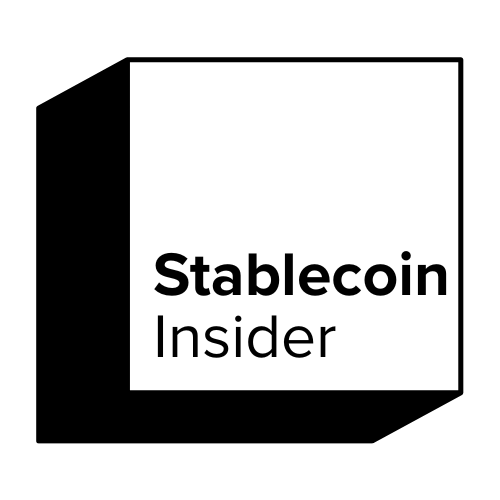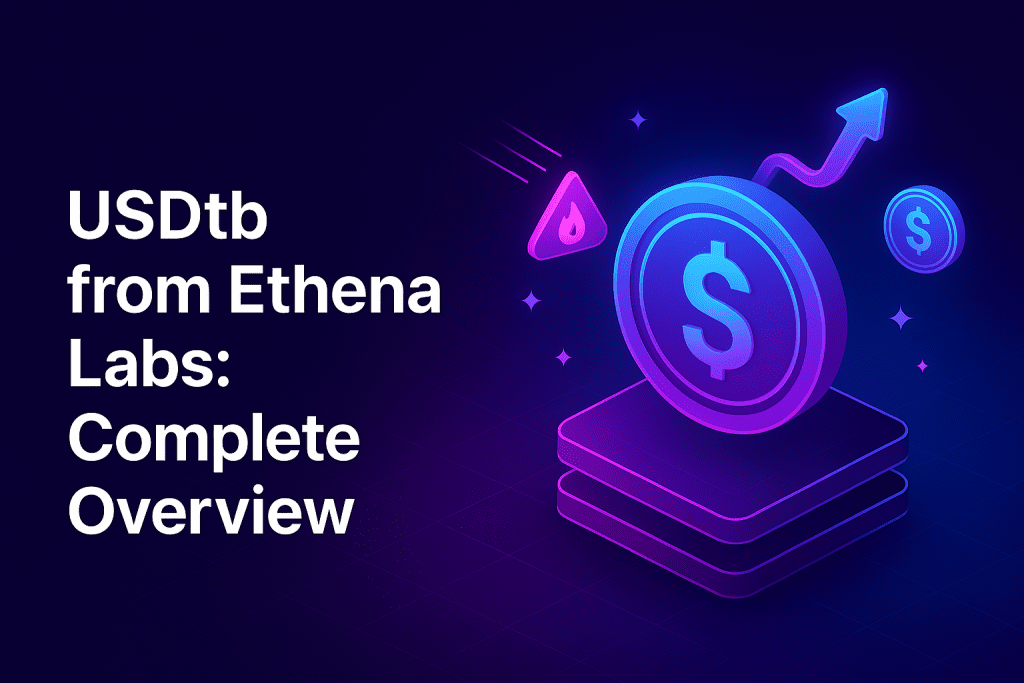USDtb is a new type of stablecoin that has quickly caught the attention of crypto investors, DeFi users, and institutional players alike.
Created by Ethena Labs, this synthetic dollar-pegged asset is designed to offer scalability, censorship resistance, and an attractive alternative to traditional fiat-backed stablecoins like USDT or USDC.
In the current regulatory and economic climate, stablecoins are playing an increasingly important role in how value moves across blockchain networks. USDtb is a standout because it isn’t backed by actual dollars in a bank account—instead, it uses a novel trading strategy to maintain its value and generate yield.
Key Takeaways:
- USDtb is a synthetic stablecoin pegged to the US dollar using a delta-neutral strategy.
- It’s issued by Ethena Labs, a company focused on building crypto-native financial infrastructure.
- Unlike USDC or USDT, it does not rely on fiat reserves held in banks.
- It’s integrated across major DeFi platforms and centralized exchanges.
- USDtb offers high on-chain yield and censorship resistance, but also carries risks like market volatility and smart contract vulnerabilities.
What is USDtb?
USDtb is a synthetic stablecoin that maintains a 1:1 peg to the US dollar but doesn’t rely on fiat reserves. Instead, it is backed by a delta-neutral basis trade strategy that involves:
- Holding spot ETH (or other crypto assets)
- Hedging that exposure with a short futures position
This strategy helps the asset maintain dollar parity without needing an actual dollar in reserve. The “b” in USDtb stands for “basis,” referring to this arbitrage-based mechanism.
Use Cases:
- Trading pairs on decentralized and centralized exchanges
- Providing liquidity in DeFi protocols
- Earning yield through staking or lending platforms
Who is Behind USDtb?
USDtb is the second stablecoin product of Ethena Labs, a Web3 infrastructure startup aiming to redefine stable value in crypto. It’s also backed by Blackrock.
- Team: Led by a group of finance and crypto experts from firms like Brevan Howard, Citadel, and Paradigm.
- Investors: Ethena Labs has attracted significant funding from VCs including Dragonfly, Arthur Hayes (BitMEX co-founder), and Galaxy Digital.
- Mission: To build scalable, censorship-resistant financial primitives for a decentralized economy.
How Does USDtb Work?
At the core of USDtb is a delta-neutral trading strategy designed to mimic the value of a US dollar without the need to hold any fiat currency. This is a powerful innovation in the world of stablecoins, especially for users seeking a fully crypto-native solution.
Here’s a simplified breakdown of the process:
- Collateral: Users deposit ETH or other supported crypto assets as collateral.
- Short Hedge: For every unit of crypto deposited, Ethena opens an equivalent short position in the perpetual futures market. This hedge is usually placed on platforms like Binance or OKX.
- Outcome: The combination of a long spot position and a short perpetual position creates a synthetic dollar exposure. The volatility of the crypto asset is neutralized, making the resulting position behave like holding a stable USD.
This delta-neutral structure allows the value of USDtb to stay close to $1 even when crypto markets are highly volatile.
Key Components of USDtb’s Design:
- Smart Contracts: The minting and redemption process is controlled by smart contracts, ensuring that user deposits and hedging actions are transparent and trustless.
- Automated Hedging: The protocol dynamically manages its short positions to ensure peg stability. As the price of collateral fluctuates, Ethena rebalances its hedge to maintain a neutral position.
- Funding Rate Arbitrage: One of the most compelling features is that the short positions often earn a funding rate from traders who are long on perpetuals. This results in a consistent yield for the protocol, which can be distributed to users.
- Price Oracles: Reliable oracles feed real-time price data to the protocol, ensuring accurate hedging and collateral management.
- Risk Engine: A robust risk management framework monitors margin ratios, exchange exposure, and potential liquidation risks in real time.
USDtb replicates the financial characteristics of the US dollar using entirely on-chain and crypto-native tools. By relying on sophisticated hedging mechanics and incentive structures, it delivers price stability, scalability, and yield—all without touching traditional banking infrastructure.
Benefits of USDtb
USDtb introduces several advantages over traditional stablecoins:
- Censorship Resistance: No need for centralized banking partners.
- Scalability: Supply can expand without fiat reserve limitations.
- Composability: Easily used across DeFi protocols, dApps, and exchanges.
- Yield Generation: Holders benefit from the basis trade’s funding rate.
- Liquidity: Supported by centralized exchanges and growing DeFi integrations.
Risks and Criticisms
While innovative, USDtb isn’t risk-free:
- Smart Contract Risk: Bugs or exploits in the protocol code.
- Volatility Risk: Extreme market moves may impact hedge effectiveness.
- Counterparty Risk: Relying on centralized exchanges for perpetuals.
- Transparency: While Ethena shares some metrics, full audits and disclosures are still in progress.
- Regulatory Risk: Synthetic assets are in a legal gray zone in many jurisdictions.
How to Mint and Use USDtb
Getting USDtb is relatively straightforward:
To Mint:
- Visit Ethena’s official platform.
- Connect your crypto wallet (e.g., MetaMask).
- Deposit supported collateral (like ETH).
- Confirm minting and receive USDtb.
Where to Use USDtb:
- Exchanges: Available on platforms like Binance, Bybit, and Uniswap.
- Wallets: Compatible with MetaMask, Ledger, and other EVM wallets.
- Use Cases:
- Trading
- Providing liquidity
- Remittances
- Yield farming
USDtb vs Other Stablecoins
| Feature | USDtb | USDT | USDC | DAI | crvUSD |
|---|---|---|---|---|---|
| Peg Mechanism | Synthetic (delta-neutral) | Fiat-backed | Fiat-backed | Crypto-collateralized | Pegged with lending collateral |
| Backing Asset | Crypto + short futures | Fiat reserves | Fiat reserves | ETH, BTC | Curve’s LLAMMA AMM |
| Yield | Yes | Minimal | Minimal | Yes | Yes |
| Decentralized? | Partially | No | No | Yes | Yes |
| Regulated? | No | Somewhat | Yes | No | No |
USDtb Ecosystem and Integrations
USDtb is rapidly growing in adoption and integrations:
- Centralized Exchanges: Listed on Binance, Bybit, BitMEX
- DeFi Protocols: Compatible with Curve, Balancer, Aave, and Lido
- Wallet Support: MetaMask, Rabby, Safe
- TVL Growth: Surpassed $1B in Total Value Locked in Q1 2025
- Developer Resources: Public SDKs, API docs, GitHub repositories
Future Outlook and Roadmap
Ethena Labs has a bold roadmap:
- Cross-Chain Expansion: Plans to launch on L2s like Arbitrum and Base
- Governance: Launch of ENA token and DAO for community governance
- Staking Module: Allowing users to earn protocol fees
- Enhanced Transparency: Real-time dashboards and third-party audits
- Regulatory Engagement: Proactive discussions with policymakers
Conclusion
USDtb is shaping up to be one of the most innovative stablecoin solutions on the market. With its crypto-native architecture, strong yield mechanisms, and integrations across DeFi and CeFi, it provides a compelling alternative to centralized fiat-backed options.
While it’s not without its risks—especially around regulation and technical reliability—USDtb represents a leap forward in the evolution of stablecoins.
Want to get involved? Visit Ethena Labs’ website to mint USDtb, explore developer tools, or join the growing community shaping the future of decentralized finance.
Read Next:
FAQs
- Is USDtb backed by actual dollars?
- No. It uses a delta-neutral basis trading strategy instead of fiat reserves.
- How does USDtb remain stable without fiat?
- By holding spot crypto and shorting futures, the price exposure is neutralized to maintain a dollar peg.
- Can I earn yield by holding USDtb?
- Yes. Yield is generated through funding rate arbitrage and passed on to users.
- Where can I buy or mint USDtb?
- On Ethena Labs’ website or through exchanges like Binance and Bybit.
- Is USDtb safe to use?
- It’s relatively new and carries risks such as smart contract bugs and exchange reliance.
- What makes USDtb different from DAI or crvUSD?
- DAI is backed by crypto collateral; crvUSD uses LLAMMA; USDtb uses a synthetic delta-neutral model.
- Who audits the USDtb protocol?
- Third-party audits are underway; some code is already open-source.
- How does Ethena Labs generate yield?
- Through funding rate arbitrage on perpetual futures exchanges.
- What happens to USDtb in extreme market conditions?
- The protocol has liquidation mechanisms and risk controls, but extreme volatility remains a concern.
- Can USDtb be used for international payments?
- Yes, thanks to its dollar peg and compatibility with wallets and exchanges, it’s ideal for remittances and borderless transfers.

